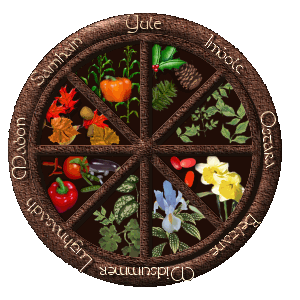Would you like to make this site your homepage? It's fast and easy...
Yes, Please make this my home page!
Wheel of the Year

Sabbats
December 21
YULE, also called Longest Night.
This begins the celebration of Yule. The Goddess gives birth to the god, the
Child of Promise who is reborn with the returning sun.
Yule is a joyous celebration of family
and friends, of peace and love and positive energy. Witches incorporate ancient
pagan traditions into our festivities, traditions like yule logs, giving gifts,
wassail cups, mistletoe charms, bringing evergreens into the home and decorating
a tree.
February 2
IMBOLC, also called Imbolg, Oimelc, Candlemas, & Earrach.
This is the rebirth of the year. Winter buds appear on bare trees and green life
stirs under the frozen earth. The infant Sun (the god) grows in size and
strength.
Imbolc is fire festival of lights, sacred to the Irish goddess Brigid. Witches
light candles to illuminate the winter darkness.
March 21
SPRING EQUINOX, also called Ostara or Eostre.
The year is in perfect balance between light and darkness. The god is now a
green youth and the Goddess is in her Maiden aspect. Their courtship dance
begins.
Ostara is a solar festival of fire, light and fertility sacred to the Saxon
goddess of Spring, Ostara/Eostre. Witches follow the old pagan custom of dying
or painting hard-boiled eggs.
May 1
BELTAINE, also called May Eve, Samradh, Cetsamain and Walpurgis Night.
The light has grown longer and everything is blooming. The virile young Lord and
the fertile Maiden celebrate the consummation of their relationship.
It is a fire and fertility festival
that celebrates the transformation from Maiden to Mother through the mystery of
sexuality. Beltane Eve is prime time for the Great Rite. Witches gather dew on
May morning, put flowers on our altars, leave offerings for fairies, and tend
sacred places like groves and wells.
June 22
LITHA, also called Summer Solstice, Midsummer and St. John's Day.
The Earth is in full bloom. The Mother is pregnant and the god (the Sun) is King
of Summer, at the peak of his powers.
Litha is the longest day, marking the division of the year. Witches celebrate
abundance, fertility, virility, the beauty and bounty of Nature. This is a good
time for handfastings and male rituals, for workings of empowerment,
consummation or culmination.
August 1
LUGHNASADH, also called Lammas, Lunasa and Hlafmass, the Festival of Loaves.
The days start growing shorter and the fields are heavy with crops ready to be
harvested. The corn king is sacrificed and mourning begins for the death of the
god (the Sun).
A festival of fire and light named
for the Celtic god Lugh/Llew, Lord of Light. Witches bake bread, put grain on
our altars, count our blessings and give thanks to the Goddess.
September 21
MABON, also called Autumn Equinox.
Crops are harvested, light and darkness are again in balance. The god sleeps in
the womb of the Goddess, waiting to be reborn.
Mabon is sacred to the Celtic god Mabon, a Son of Light, son of the mother
goddess Modron. This second harvest festival is a time to enjoy the fruits of
your labor and give thanks for abundance. Witches put the fruits of the season
on our altars, bake bread and pies, work magic to balance imbalances.
October 31
SAMHAIN (pronounced sow-en), also called Halloween, Allantide, Geimredh and All
Hallows Eve.
Samhain literally means "summer's end". To the Celts, Samhain was a
turning point from light into darkness, they believed that on this night there
was access to the land of the dead, Tir nan Og. Many Pagans/Wiccans today
celebrate Samhain on between October 31st - November 2nd. It is a day that we
honor our dead Samhain is also a
time we reflect on the year. This is our New Year, when the Wheel of the Year
has gone full circle and begins again.
BACK
